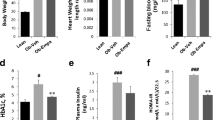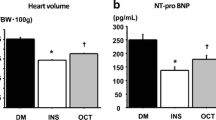Abstract
Diabetes mellitus type 2 (DM2) is a disease with increasing importance in modern societies and insufficient treatment options. Pharmacological stimulation of insulin signaling, which is blunted in DM2, is a promising approach to treat this disease. It has been shown that activation of the angiotensin (Ang)-(1–7)/Mas axis of the renin–angiotensin system leads to an improved glucose uptake. In this study, we intended to evaluate, whether this effect could be exploited therapeutically. We first confirmed that Ang-(1–7) improves insulin signaling and glucose uptake in vitro in cultured cardiomyocytes. We then evaluated the therapeutic effect of a newly developed hydro-xypropyl-β-cyclodextrin-based Ang-(1–7) nano-formulation in a novel transgenic rat model of inducible insulin resistance and DM2. The chronic administration of this compound prevented the marked elevation in blood glucose levels in these rats at a dose of 30 μg/kg, reversed the established hyperglycemic state at a dose of 100 μg/kg, and resulted in improved insulin sensitivity, reduced plasma insulin and decreased diabetic nephropathy. In conclusion, an oral Ang-(1–7) formulation reverses hyperglycemia and its consequences in an animal model of DM2 and represents a novel therapeutic option for the treatment of DM2 and other cardio-metabolic diseases.
Key message
-
A novel rat model with inducible diabetes can be used to evaluate new therapies.
-
Angiotensin-(1–7) is effective in an oral formulation packaged in cyclodextrine.
-
Angiotensin-(1–7) is a promising antidiabetic drug.






Similar content being viewed by others
References
Dandona P, Aljada A (2002) A rational approach to pathogenesis and treatment of type 2 diabetes mellitus, insulin resistance, inflammation, and atherosclerosis. Am J Cardiol 90:27G–33G
Mauvais-Jarvis F, Kahn CR (2000) Understanding the pathogenesis and treatment of insulin resistance and type 2 diabetes mellitus: what can we learn from transgenic and knockout mice? Diabetes Metab 26:433–448
Molitch ME, DeFronzo RA, Franz MJ, Keane WF, Mogensen CE, Parving HH, Steffes MW (2004) Nephropathy in diabetes. Diabetes Care 27(Suppl 1):S79–S83
KDOQI (2007) Clinical practice guidelines and clinical practice recommendations for diabetes and chronic kidney disease. Am J Kidney Dis 49:S12–154
Prasad A, Quyyumi AA (2004) Renin–angiotensin system and angiotensin receptor blockers in the metabolic syndrome. Circulation 110:1507–1512
Giacchetti G, Sechi LA, Rilli S, Carey RM (2005) The renin–angiotensin–aldosterone system, glucose metabolism and diabetes. Trends Endocrinol Metab 16:120–126
Strazzullo P, Galletti F (2004) Impact of the renin–angiotensin system on lipid and carbohydrate metabolism. Curr Opin Nephrol Hypertens 13:325–332
Gurley SB, Coffman TM (2007) The renin–angiotensin system and diabetic nephropathy. Semin Nephrol 27:144–152
Putnam K, Shoemaker R, Yiannikouris F, Cassis LA (2012) The renin–angiotensin system: a target of and contributor to dyslipidemias, altered glucose homeostasis, and hypertension of the metabolic syndrome. Am J Physiol Heart Circ Physiol 302:H1219–H1230
Bader M (2010) Tissue renin–angiotensin–aldosterone systems: targets for pharmacological therapy. Ann Rev Pharmacol Toxicol 50:439–465
Boustany CM, Bharadwaj K, Daugherty A, Brown DR, Randall DC, Cassis LA (2004) Activation of the systemic and adipose renin–angiotensin system in rats with diet-induced obesity and hypertension. Am J Physiol Regul Integr Comp Physiol 287:R943–R949
Crackower MA, Sarao R, Oudit GY, Yagil C, Kozieradzki I, Scanga SE, Oliveira-dos-Santos AJ, da Costa J, Zhang L, Pei Y et al (2002) Angiotensin-converting enzyme 2 is an essential regulator of heart function. Nature 417:822–828
Santos RA, Ferreira AJ, Pinheiro SV, Sampaio WO, Touyz R, Campagnole-Santos MJ (2005) Angiotensin-(1–7) and its receptor as a potential targets for new cardiovascular drugs. Expert Opin Investig Drugs 14:1019–1031
Tipnis SR, Hooper NM, Hyde R, Karran E, Christie G, Turner AJ (2000) A human homolog of angiotensin-converting enzyme. Cloning and functional expression as a captopril-insensitive carboxypeptidase. J Biol Chem 275:33238–33243
Reudelhuber TL (2005) The renin–angiotensin system: peptides and enzymes beyond angiotensin II. Curr Opin Nephrol Hypertens 14:155–159
Santos RA, Simoes e Silva AC, Maric C, Silva DMR, Machado RP, de Buhr I, Heringer-Walther S, Pinheiro SVB, Lopes MT, Bader M et al (2003) Angiotensin-(1–7) is an endogenous ligand for the G-protein coupled receptor Mas. Proc Natl Acad Sci U S A 100:8258–8263
Fraga da Silva RA, Pinheiro SVB, Goncalves ACC, Alenina N, Bader M, Santos RA (2008) The NO-mediated antithrombotic effect of angiotensin-(1–7) is abolished in mas-knockout mice. Mol Med 14:28–35
Santos RA, Ferreira AJ (2007) Angiotensin-(1–7) and the renin–angiotensin system. Curr Opin Nephrol Hypertens 16:122–128
Niu MJ, Yang JK, Lin SS, Ji XJ, Guo LM (2008) Loss of angiotensin-converting enzyme 2 leads to impaired glucose homeostasis in mice. Endocrine 34:56–61
Bindom SM, Hans CP, Xia H, Boulares AH, Lazartigues E (2010) Angiotensin I-converting enzyme type 2 (ACE2) gene therapy improves glycemic control in diabetic mice. Diabetes 59:2540–2548
Santos SHS, Braga JF, Mario EG, Porto LCJ, Botion LM, Alenina N, Bader M, Santos RA (2010) Improved lipid and glucose metabolism in transgenic rats with increased circulating angiotensin-(1–7). Arterioscler Thromb Vasc Biol 30:953–961
Giani JF, Mayer MA, Munoz MC, Silberman EA, Hocht C, Taira CA, Gironacci MM, Turyn D, Dominici FP (2009) Chronic infusion of angiotensin-(1–7) improves insulin resistance and hypertension induced by a high-fructose diet in rats. Am J Physiol Endocrinol Metab 296:E262–E271
Marcus Y, Shefer G, Sasson K, Kohen F, Limor R, Pappo O, Nevo N, Biton I, Bach M, Berkutzki T et al (2013) Angiotensin 1–7 as means to prevent the metabolic syndrome: Lessons from the fructose-fed rat model. Diabetes 62:1121–1130
Benter IF, Yousif MH, Dhaunsi GS, Kaur J, Chappell MC, Diz DI (2008) Angiotensin-(1–7) prevents activation of NADPH oxidase and renal vascular dysfunction in diabetic hypertensive rats. Am J Nephrol 28:25–33
Dhaunsi GS, Yousif MH, Akhtar S, Chappell MC, Diz DI, Benter IF (2010) Angiotensin-(1–7) prevents diabetes-induced attenuation in PPAR-gamma and catalase activities. Eur J Pharmacol 638:108–114
Santos SHS, Fernandes LR, Mario EG, Ferreira AVM, Porto LCJ, Alvarez-Leite JI, Botion LM, Bader M, Alenina N, Santos RA (2008) Mas deficiency in FVB/N in mice produces marked changes in lipid and glycemic metabolism. Diabetes 57:340–347
Lula I, Denadai AL, Resende JM, de Sousa FB, de Lima GF, Pilo-Veloso D, Heine T, Duarte HA, Santos RA, Sinisterra RD (2007) Study of angiotensin-(1–7) vasoactive peptide and its beta-cyclodextrin inclusion complexes: complete sequence-specific NMR assignments and structural studies. Peptides 28:2199–2210
Marques FD, Ferreira AJ, Sinisterra RD, Jacoby BA, Sousa FB, Caliari MV, Silva GA, Melo MB, Nadu AP, Souza LE et al (2011) An oral formulation of angiotensin-(1–7) produces cardioprotective effects in infarcted and isoproterenol-treated rats. Hypertension 57:477–483
Fraga-Silva RA, Costa-Fraga FP, Sousa FB, Alenina N, Bader M, Sinisterra RD, Santos RA (2011) An orally-active formulation of angiotensin-(1–7) produces antithrombotic effect. Clinics 66:837–841
Kotnik K, Popova E, Todiras M, Mori MA, Alenina N, Seibler J, Bader M (2009) Inducible transgenic rat model for diabetes mellitus based on shRNA-mediated gene knockdown. PLoS ONE 4:e5124
Nigro J, Osman N, Dart AM, Little PJ (2006) Insulin resistance and atherosclerosis. Endocr Rev 27:242–259
DeFronzo RA (1997) Insulin resistance: a multifaceted syndrome responsible for NIDDM, obesity, hypertension, dyslipidaemia and atherosclerosis. Neth J Med 50:191–197
Grundy SM (2012) Pre-diabetes, metabolic syndrome, and cardiovascular risk. J Am Coll Cardiol 59:635–643
Miranda PJ, DeFronzo RA, Califf RM, Guyton JR (2005) Metabolic syndrome: definition, pathophysiology, and mechanisms. Am Heart J 149:33–45
Hainault I, Nebout G, Turban S, Ardouin B, Ferre P, Quignard-Boulange A (2002) Adipose tissue-specific increase in angiotensinogen expression and secretion in the obese (fa/fa) Zucker rat. Am J Physiol Endocrinol Metab 282:E59–E66
Batlle D, Wysocki J, Soler MJ, Ranganath K (2012) Angiotensin-converting enzyme 2: enhancing the degradation of angiotensin II as a potential therapy for diabetic nephropathy. Kidney Int 81:520–528
Singh T, Singh K, Sharma PL (2010) Ameliorative potential of angiotensin1–7/Mas receptor axis in streptozotocin-induced diabetic nephropathy in rats. Methods Find Exp Clin Pharmacol 32:19–25, 1434160
Giani JF, Munoz MC, Pons RA, Cao G, Toblli JE, Turyn D, Dominici FP (2011) Angiotensin-(1–7) reduces proteinuria and diminishes structural damage in renal tissue of stroke-prone spontaneously hypertensive rats. Am J Physiol Ren Physiol 300:F272–F282
Giani JF, Burghi V, Veiras LC, Tomat A, Munoz MC, Cao G, Turyn D, Toblli JE, Dominici FP (2012) Angiotensin-(1–7) attenuates diabetic nephropathy in Zucker diabetic fatty rats. Am J Physiol Ren Physiol 302:F1606–F1615
Pinheiro SVB, Ferreira AJ, Kitten GT, da Silveira KD, da Silva DA, Santos SHS, Gava E, Castro CH, Magalhaes JA, da Mota RK et al (2009) Genetic deletion of the angiotensin(1–7) receptor Mas leads to glomerular hyperfiltration and microalbuminuria. Kidney Int 75:1184–1193
Taniguchi CM, Emanuelli B, Kahn CR (2006) Critical nodes in signalling pathways: insights into insulin action. Nat Rev Mol Cell Biol 7:85–96
Folli F, Kahn CR, Hansen H, Bouchie JL, Feener EP (1997) Angiotensin II inhibits insulin signaling in aortic smooth muscle cells at multiple levels. A potential role for serine phosphorylation in insulin/angiotensin II crosstalk. J Clin Invest 100:2158–2169
Folli F, Saad MJ, Velloso L, Hansen H, Carandente O, Feener EP, Kahn CR (1999) Crosstalk between insulin and angiotensin II signalling systems. Exp Clin Endocrinol Diabetes 107:133–139
Giani JF, Gironacci MM, Munoz MC, Pena C, Turyn D, Dominici FP (2007) Angiotensin-(1 7) stimulates the phosphorylation of JAK2, IRS-1 and Akt in rat heart in vivo: role of the AT1 and Mas receptors. Am J Physiol Heart Circ Physiol 293:H1154–H1163
Sampaio WO, Souza dos Santos RA, Faria-Silva R, Mata Machado LT, Schiffrin EL, Touyz RM (2007) Angiotensin-(1–7) through receptor Mas mediates endothelial nitric oxide synthase activation via Akt-dependent pathways. Hypertension 49:185–192
Munoz MC, Giani JF, Burghi V, Mayer MA, Carranza A, Taira CA, Dominici FP (2012) The Mas receptor mediates modulation of insulin signaling by angiotensin-(1–7). Regul Pept 177:1–11
Hotamisligil GS, Peraldi P, Budavari A, Ellis R, White MF, Spiegelman BM (1996) IRS-1-mediated inhibition of insulin receptor tyrosine kinase activity in TNF-alpha- and obesity-induced insulin resistance. Science 271:665–668
Aguirre V, Werner ED, Giraud J, Lee YH, Shoelson SE, White MF (2002) Phosphorylation of Ser307 in insulin receptor substrate-1 blocks interactions with the insulin receptor and inhibits insulin action. J Biol Chem 277:1531–1537
Andreozzi F, Laratta E, Sciacqua A, Perticone F, Sesti G (2004) Angiotensin II impairs the insulin signaling pathway promoting production of nitric oxide by inducing phosphorylation of insulin receptor substrate-1 on Ser312 and Ser616 in human umbilical vein endothelial cells. Circ Res 94:1211–1218
Liu C, Lv XH, Li HX, Cao X, Zhang F, Wang L, Yu M, Yang JK (2012) Angiotensin-(1–7) suppresses oxidative stress and improves glucose uptake via Mas receptor in adipocytes. Acta Diabetol 49:291–299
Mario EG, Santos SH, Ferreira AV, Bader M, Santos RA, Botion LM (2012) Angiotensin-(1–7) Mas-receptor deficiency decreases peroxisome proliferator-activated receptor gamma expression in adipocytes. Peptides 33:174–177
Acknowledgments
The authors would like to thank Astrid Schiche for excellent assistance in the animal experiments.
Disclosure
The authors have no conflict of interest to disclose.
Author information
Authors and Affiliations
Corresponding authors
Electronic supplementary material
Below is the link to the electronic supplementary material.
ESM 1
(PDF 63 kb)
Rights and permissions
About this article
Cite this article
Santos, S.H.S., Giani, J.F., Burghi, V. et al. Oral administration of angiotensin-(1–7) ameliorates type 2 diabetes in rats. J Mol Med 92, 255–265 (2014). https://doi.org/10.1007/s00109-013-1087-0
Received:
Revised:
Accepted:
Published:
Issue Date:
DOI: https://doi.org/10.1007/s00109-013-1087-0




